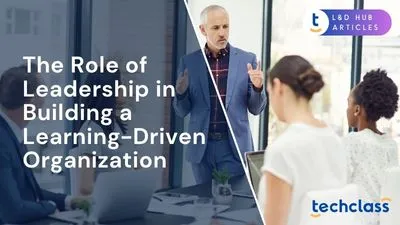
Organizational change is a constant in today's fast-paced, global business environment. Companies must evolve with new technologies, market shifts, and customer expectations or risk being left behind. Yet change efforts often fall short – studies have long found that about 70% of change initiatives. A key reason is not the lack of technical plans, but the lack of effective leadership to guide people through change. Employees frequently resist or feel anxious about change, especially if they do not trust leadership or understand the purpose. In fact, only 27% of employees believe their leadership is trained to lead teams through change. This low confidence highlights a critical gap: to achieve organizational change success, companies need to invest in training their leaders to become change-capable.
When leaders are well-prepared to manage change, they set a clear vision, communicate the "why," and steer teams through uncertainty. Strong change leadership can turn resistance into buy-in, minimize disruption, and keep employees engaged during transitions. Conversely, poor leadership during change can lead to confusion, fear, and failure. It's telling that nearly one-third of CEOs have been fired for poor change management. The stakes are high. This article explores how HR professionals and business leaders can train and develop leaders for organizational change success. We will cover why leadership training is crucial, the key skills change leaders need, effective methods for developing those skills, and how to foster internal change leaders with a global perspective.
Leadership quality can make or break a change initiative. While project plans and processes are important, it is leaders who motivate employees, navigate obstacles, and sustain momentum throughout the change. Research shows that people-related factors account for the majority of failed changes. For example, negative employee attitudes and lack of management support are cited in up to 70% of failed change projects. Training leaders to better handle these people challenges significantly improves outcomes.
Trained leaders understand how to place people before process during change. They proactively communicate and involve their teams, rather than imposing top-down edicts. Leaders skilled in change management foster trust and transparency – they clarify the strategic goals, listen to concerns, and adjust their approach based on feedback. This inclusive leadership style directly impacts success. A recent consulting survey found that although 74% of leaders believed they involved employees in creating change strategy, only 42% of employees actually felt included. This perception gap can be closed by developing leaders’ abilities in communication and engagement.
Another benefit of training is that it prepares leaders to manage resistance. Change naturally triggers uncertainty and pushback from employees. A well-trained change leader knows how to address resistance with empathy and clear messaging, instead of viewing it as mere defiance. According to data, 74% of employees think leaders need to do more to understand why people resist change. Equipped with skills in emotional intelligence and stakeholder engagement, leaders can uncover root causes of resistance – such as fear of the unknown or lack of awareness – and work to resolve them. In short, investing in leadership training builds the capability to tackle the human side of change, which is often where transformations succeed or fail.
Crucially, training leaders for change pays off in organizational performance. Companies that handle change effectively – often called "change accelerators" – far outperform those that do not. A study by WTW found that organizations rated highly by their employees in change effectiveness experienced 2.6 times more revenue growth than those with poor change leadership. These high performers make it a priority to equip their leaders with the skills and resources to lead change. They treat change leadership as a core competency at all levels of management. By contrast, many struggling companies fail to do this basic step. Only 25% of organizations have senior leaders whom employees consider highly effective at managing change. The evidence is clear: training leaders in change management is not a "nice to have" – it is essential for achieving the goals of any major change and avoiding costly failures.
Training programs for change leaders should focus on building a specific set of leadership skills and competencies. Leading change requires a balance of strategic thinking, people skills, and personal adaptability. Based on research and expert insights, here are some of the key competencies that change-capable leaders must develop:
By focusing leadership development on these competencies – from the "soft skills" of empathy and communication to the strategic skills of planning and execution – organizations can build a cadre of leaders who are truly equipped to lead change. Next, we will discuss how to instill these skills through effective training methods.
Training leaders for organizational change success requires more than a one-off workshop. It should be a continuous, multifaceted process that combines education, practice, and feedback. Here are several proven methods and strategies to develop change leadership skills in your organization:
By leveraging a combination of these methods – formal training, hands-on practice, coaching, and a supportive learning culture – HR and L&D professionals can systematically build a pipeline of leaders prepared to drive change. It's important to tailor the approach to the organization’s context; for example, a fast-growing tech firm might emphasize on-the-job pilots and coaching, while a large established enterprise might implement comprehensive workshops and formal courses. In all cases, the commitment to developing change leaders needs to start at the top.
While external consultants can provide expertise, sustainable change success largely depends on empowering internal leaders at all levels to champion change. Internal leaders have the advantage of knowing the company’s culture, history, and people. Training programs should therefore identify and develop change agents from within the organization – not just at the executive tier, but also middle managers and frontline supervisors who influence day-to-day operations. When change leadership skills are disseminated broadly, the organization builds an internal network of change champions who can support each other and spread best practices.
One approach is to establish a formal internal change leadership program or community. For instance, HR can create a "change champions network" comprising managers from different departments or regions who receive specialized training. These internal change leaders can then take the lead in their respective areas during major transformations, acting as liaisons between top management and employees. They model the desired behaviors locally and help address issues in real time. Organizations like Prosci, a global change management firm, note that building internal competency at all levels and a common language for change is a critical success factor for large-scale change. In practice, this might mean training hundreds of managers on foundational change skills and equipping them with toolkits and communication templates to use during initiatives.
In a globally distributed company, a global perspective on leadership training is vital. Changes often span multiple countries and cultures, whether it's a multinational rolling out a new software globally or a corporation integrating an acquisition across regions. Leaders must be trained to both plan change globally and implement it locally. What does this entail? At the global planning level, leadership training should emphasize consistent messaging, shared methodologies, and alignment with overall strategy. Leaders from different markets should speak the same change language and understand the unified vision. Yet, at the local implementation level, leaders need cultural agility – the ability to adapt messages and tactics to fit local norms and employee expectations. For example, a style of communication that motivates employees in one country might not resonate in another, so local leaders should tailor the approach appropriately.
Organizations can foster this balance by appointing executive sponsors or champions in each major region who coordinate with one another. A global change leader network can ensure that lessons learned in one locale are shared with others, and that successes get replicated. Training programs might include cross-cultural communication workshops or international rotations to expose leaders to different perspectives. The goal is a cohort of leaders worldwide who are unified in purpose but flexible in execution. As one Prosci guide suggests, find influential sponsors in each region and support them with a cohesive plan while giving them leeway to adjust to local culture. This approach builds both global consistency and local relevance in change efforts.
It's also important to consider that “global perspective” means being aware of external global trends that necessitate change. Leaders should be educated on global market forces, emerging technologies, and cross-industry best practices. This broad awareness helps them anticipate changes and proactively develop their teams for what's coming. A trained leader with a global outlook will, for example, recognize early when a new international regulation or a disruptive innovation requires internal change, and then mobilize the organization accordingly.
In summary, developing internal change leaders with a global perspective involves: widening the pool of trained leaders within the company, breaking out of silos, and ensuring training content and experiences have a cross-cultural dimension. By doing so, companies create an internal engine for change that can respond quickly and uniformly to challenges and opportunities around the world.
Training leaders for organizational change success is not a one-time project, but an ongoing mission. In an era where transformation is the norm rather than the exception, the most resilient organizations are those that build a culture of continuous change leadership development. This means that HR and business executives treat change readiness as a core leadership competency to be strengthened regularly, just like financial acumen or operational excellence.
A few final takeaways for fostering this culture: lead by example from the top – when senior leaders prioritize their own development in change leadership, it sends a powerful message through the ranks. Celebrate and reward effective change leaders, highlighting how their efforts made a difference to business outcomes. Integrate change leadership criteria into leadership assessment and promotion decisions, ensuring that those who excel in guiding teams through change advance in the organization.
Additionally, keep an eye on the evolving landscape. New challenges like digital disruption, remote work, or global crises (as seen during the COVID-19 pandemic) will continuously test leaders’ adaptability. Be ready to update training programs to address these new realities – whether it's training leaders to manage change fatigue and employee well-being, or teaching them to leverage data analytics to inform change strategies. An organization that continually learns and adapts in how it develops its leaders will stay ahead of the curve.
Finally, recognize that successful organizational change is a team effort that extends beyond individual leaders. It flourishes when there is alignment: executives sponsoring and championing the effort, managers at all levels equipped to implement, and employees engaged in the process. Training and developing leaders is the catalyst for this alignment. With skilled, confident leaders at the helm, even the most complex change can become an opportunity for growth rather than a threat. In the end, investing in leadership training for change is an investment in the organization’s future – enabling it to not only survive change, but to harness it for sustained success.
Leadership training equips leaders with essential skills to guide teams through change, reduce resistance, and ensure successful transformations.
Change leaders should focus on communication, collaboration, strategic planning, empathy, stakeholder engagement, adaptability, and cultural awareness.
Organizations should combine formal courses, workshops, coaching, stretch assignments, feedback, and fostering a continuous learning culture.
Internal leaders understand company culture and can champion change locally, building a network of change agents for sustainable success.
A global perspective ensures cultural agility, consistent messaging across regions, and preparedness for international market shifts.


